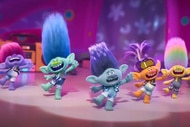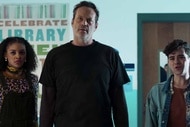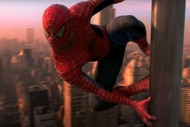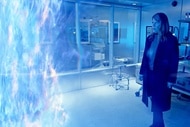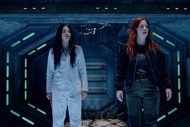Create a free profile to get unlimited access to exclusive videos, sweepstakes, and more!
The 25 scariest sci-fi movies ever made, ranked from 'Aliens' to 'Invisible Man'
In space, no one can hear you scream. But, in movie theaters, everyone can hear you scream when you watch these chilling sci-fi flicks.
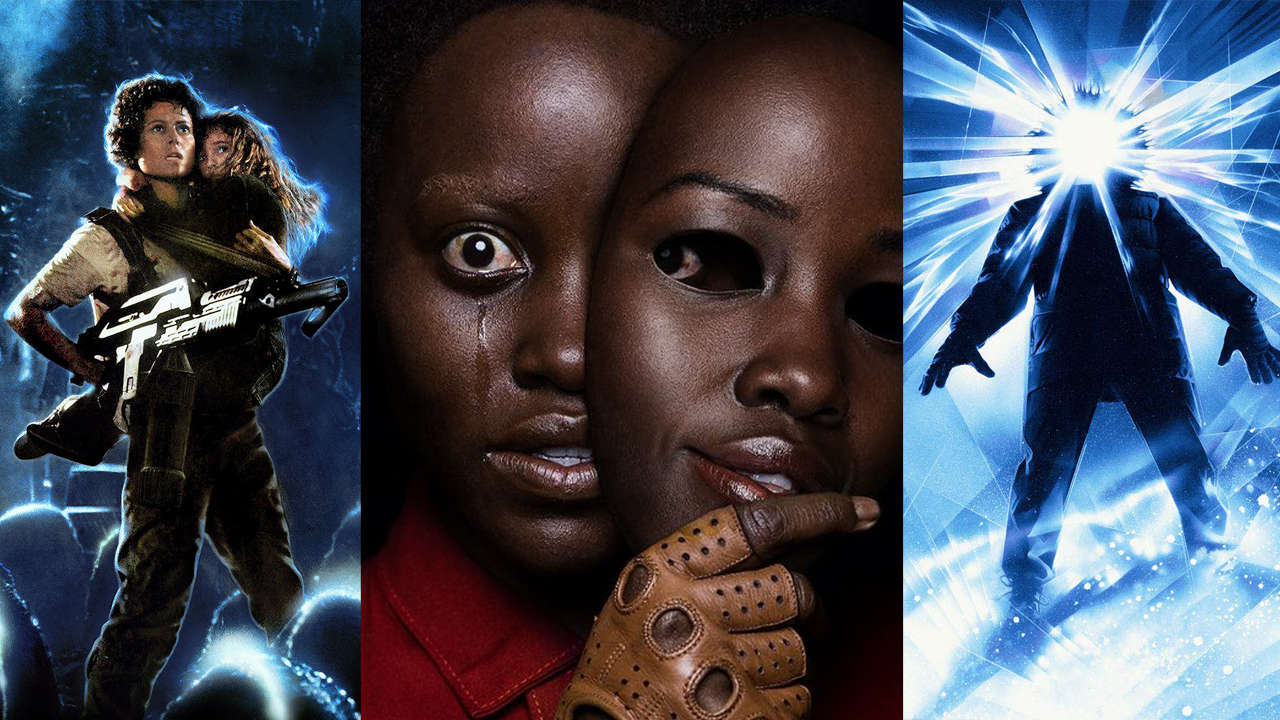
Aliens is one of those sequels few would begrudge you for thinking is better than the original.
Alien (1979), Ridley Scott’s frightening and claustrophobic trip into space with the crew of the Nostromo, is still the Alien franchise’s scariest movie, but James Cameron’s blockbuster sequel — released 35 years ago this year— is the series’ most thrilling entry. Cameron’s action-horror hybrid sparked a new (and terrifying) sci-fi genre when it brought Ellen Ripley (Sigourney Weaver) back to the big screen after a seven-year absence, where she was joined by a team of colonial space marines to combat a horde of acid-bleeding xenomorphs and their lethal Queen.
Cameron maintained the gritty, blue-collar aesthetic from Scott’s original film while giving the sequel a strong dose of adrenaline-fueled action mixed with intense scares. This then-unique approach to the material allowed the writer-director to elevate both the horror and sci-fi genres by ratcheting up the emotional stakes for Ripley as well, as our hero struggles to save herself and her surrogate daughter, Newt, from the galaxy’s equivalent of high-octane nightmare fuel.
Halloween may not seem like the perfect time to revisit Aliens or Ripley's first battle with her greatest enemy, but if you need a break from Freddy, Jason and Michael, then put all the lights on in your house and check out these sci-fi scare-fests.
25. Possessor (2020)
David Cronenberg’s son, Brandon Cronenberg, writes and directs this underrated 2020 psychological horror film set in the near future, a movie that uses its over-the-top premise to provoke more than entertain.
Possessor follows corporate assassin Tasya Vos (Andrea Riseborough), who uses brain implants to inhabit other people’s bodies and will them to commit assassinations in service of the company that employs her. When the side effects from her successful career as a puppeteer of surrogate killers start to take a toll on Vos’ psyche, she is drawn into a complicated web of sex, duality, and practical (and bloody) visual effects. Possessor is a movie full of great ideas that never fully captures or executes their potential. The director’s constantly grim and humorless tone gets in the way of exploring these interesting concepts through characters that audiences can relate to, with the end result being a movie full of deep and rich thematic ambitions that comes up unfortunately shallow with its ability to resonate beyond its trappings as a sci-fi body horror hybrid.
24. The Hidden (1987)
The Hidden is low-budget sci-fi done right; a tightly-wound thriller directed by Jack Sholder that centers on FBI Special Agent Lloyd Gallagher (Kyle MacLachlan), who is forced to team up with a Los Angeles cop to hunt down a very unique “criminal”: An alien slug that takes over human hosts and alters their behaviors. Solidly structured and assuredly plotted, The Hidden is “The Thing meets The Fugitive” and is just as horrifying as the former and as intense as the latter.
23. Color Out of Space (2020)
Color Out of Space is Richard Stanley’s love letter to Lovecraftian horror and old-school, 1950s, drive-in sci-fi.
Stanley’s first movie since 1996’s infamous bomb, The Island of Dr. Moreau, Color is based on Lovecraft’s short story and stars Nicolas Cage as Nathan Gardner, a father who joins his family in a battle against a mutant organism from space after a meteor crashes down on their farm’s front yard. Cage gives an interesting, if gonzo, performance as the alien invaders find new and visually stunning ways to infect and alter the bodies and minds of their hosts.
As returns to form go, they don’t get much better than Stanley’s work here. The technicolor visuals he tells this trippy nightmare with are unlike any genre fans have seen before, as Color Out of Space strives to deliver a unique sci-fi experience that, love it or hate it, never disappoints in the scares department and always searches for new ways to bring Lovecraft’s signature cosmic horror to life.
22. Prometheus (2013)
Ridley Scott returned to the franchise he created more than 30 years later and made something wholly bizarre and unexpected with Prometheus. This noble misfire acts, ostensibly, as a prequel to the first Alien, as it takes some crazy narrative detours and ends up playing more like Tree of Life with giant rubber monsters. But those monsters, especially the embryonic one that star Noomi Rapace has to bloodily remove from her body in a coffin-sized surgical chamber, are (mostly) convincing.
Prometheus co-writer Damon Lindelof, working from an earlier draft by Passengers writer Jon Spaihts and off Ridley Scott’s mandates, made the connections to the original film looser and the narrative more elliptical. The result was a movie that seemed to alienate (pun intended) as many viewers as it attracted. Those looking for an honest-to-god Alien movie would probably have been disappointed, but those willing to give into its weirdness, from its WTF opening to its operatic climax (rolling spaceship, giant squid-beast and all), were greatly rewarded.
21. Slither (2006)
Slither, James Gunn’s feature directorial debut, is as gory as it is funny; a clever and unsettling subversion of the body snatchers genre. Set in a small town, the movie follows a local sheriff (Nathan Fillion) who struggles to protect a quirky band of survivors when alien parasites slowly (and violently) take over the population. The tonal tightrope Gunn walks between black comedy and body horror would be tricky in any other filmmaker’s hands, but the future Guardians of the Galaxy helmer makes it look effortless. Slither was not a commercial hit, but its inspired take on the genre’s familiar tropes has deservedly earned the film cult status.
20. Pitch Black (2000)
The elevator pitch for Pitch Black is “Alien on a desert world,” and on that basic conceit, the movie more than delivers.
A pre-Fast & Furious Vin Diesel lends his gravelly voice to blind convict-turned-anti-hero Riddick as he and the survivors of a crashed spaceship must survive the local alien wildlife that comes out of hibernation during a rare eclipse. The flesh-eating aliens hunt at night with bat-like sonar, and Riddick is the only one who can see them thanks to his special vision enhancements. Writer-director David Twohy’s low-budget movie is a slow-burn, fat-free scare-fest full of some of the best sci-fi world-building and creature designs since Alien. As many imitators can attest, it’s not easy to find a unique spin on an Alien-like concept that effectively delivers thrills and tension. Not only does Pitch Black pull it off, especially with the climax’s shocker twist, it does so in a way that makes the movie just as entertaining now as it was 21 years ago.
19. Altered States (1980)
In Altered States, William Hurt plays a Harvard scientist whose experiments on himself cause him to genetically regress in increasingly trippy, nightmarish ways. Director Ken Russell’s flair for genre-bending visuals blended with a sexualized tone that can best be described as unsettling radiates off his movie like heat. He inflicts his cast of heady scientists, who seem to speak only in lines one would find in a Ph.D. dissertation, with primal hallucinations that rocket them back through millions of years of evolution. It is a deliberately-paced visual assault of practical body horror effects that literally devolves into a meditative study of human nature at the hands of brilliant scientists who have lost touch with what it means to be human.
18. Cloverfield (2008)
Cloverfield marked the start of producer J.J. Abrams’ “Mystery Box” approach to marketing, with the monster movie going viral with a jarring teaser trailer that dropped featuring the film’s signature shot — the Statue of Liberty’s decapitated head rolling to a stop on an NYC street — and a release date of “01.16.08.” Fan speculation spun into some very far-fetched areas of what the Matt Reeves-directed movie could be (like, sigh, a Voltron film) before audiences discovered that Cloverfield was an intense, grounded monster movie all told through a very gritty, found-footage lens as a group of terrified friends struggle to get through New York City in the middle of a giant monster attack. Rob (Michael Stahl-David) leads his pals through, under, and around the monster’s debris-heavy wake on a mission to save the estranged love of his life (Odette Annable), a journey fraught with tension, terror, and a refreshing amount of solid character beats, thanks to Drew Goddard’s character-first screenplay.
17. Sea Fever (2019)
Sea Fever is one of the most underrated films of the last decade. It mixes the close-quarters paranoia of The Thing with the unrelenting tension of Jaws, and confines it all on a research boat in the middle of an ocean home to some parasitic larvae that have infected the ship’s water supply. Written and directed by Neasa Hardiman, Sea Fever is an eerily timely quarantine thriller that never runs out of ways to surprise or terrify — especially during its haunting final moments.
16. 10 Cloverfield Lane (2016)
Director Dan Trachtenberg’s 10 Cloverfield Lane did not start as a movie under the short-lived “Cloverfield Universe” banner, but producer J.J. Abrams retroactively used the film to spark an interconnected franchise. The end result is a contained, sci-fi thriller with the highest possible emotional stakes executed with the help of one of the most engaging and unlikely ensembles the genre has recently seen.
After fleeing a relationship and getting into a near-fatal car accident, Mary Elizabeth Winstead’s character finds herself rescued by John Goodman’s deranged loner and confined to his bomb shelter. They are joined by a likable misfit played by John Gallagher, Jr., who must team up with Winstead to survive not just Goodman’s growing paranoia but also the alien threat that eventually justifies it. Cloverfield Lane is one of those movies that keeps you at the edge of your seat from the jump, and Tractenberg excels at grounding all the genre twists and tension on the backs of a lead character you can’t help but invest in.
If the film’s War of the Worlds-y climax outside the bomb shelter feels tacked on, it was; test screenings and internal conversations among the filmmakers convinced them to end the movie with a more action-y finale. But up until that mixed bag of an ending, 10 Cloverfield Lane is a welcome and very rewatchable addition to the genre.
15. Scanners (1981)
Director David Cronenberg’s Scanners is firmly indoctrinated into the Cult Movie Hall of Fame, thanks in large part to an iconic scene early in the film that features an exploding head.
Scanners is a barebones sci-fi thriller about a man capable of telekinesis and psychokinesis forced to hunt down others like him. His hunt takes him and audiences on a dark and unsettling tour of where government bureaucracy and supernatural science intersect, where individuals with the ability to weaponize thoughts are subjugated by those who think of them only as threats. Despite its low-budget trappings, Scanners packs in a considerable amount of deep thematic ideas among all the gore and unsettling bits.
14. Us (2019)
Us, Oscar winner Jordan Peele’s follow-up to Get Out, sees the talented filmmaker tackle clones in an uneven, but suspenseful, thriller full of heady, sci-fi ideas and earned jump scares. But Peele’s reach exceeds his grasp in the execution of those ideas, as the film's core premise and concept come with some glaring plot holes that leave one questioning the logic of the world Peele has built instead of fully being immersed in it. The movie’s most successful element, outside of Peele’s exceptional ability to milk tension and humor from his scary set pieces, is Lupita Nyong’o. Her duel performance as a frightened suburban mom confronting her emotionally and physically traumatized doppelganger is an all-timer; it’s shameful that the Oscars didn’t acknowledge her incredible work.
13. Happy Death Day (2017)
Happy Death Day is one of the best horror movie premises in a long time: A slasher movie victim/heroine gets caught in a time loop and has to Groundhog Day her way out of it. This hit Blumhouse entry, from director Christopher Landon, is the Edge of Tomorrow of horror movies; it takes the tried and true (and tired) time loop trope and gives it an inventive and subversive shot in the arm. The scares and tension unfold in unexpected ways, even though the same events are repeated.
Landon and screenwriter Scott Lobdell make sure that the time loops ratchet up the stakes while revealing clues as to why all of this is happening in ways that make the plot a riveting puzzle for the audience to solve — a plot they are never ahead of. Horror movies are often predictable affairs, and Happy Death Day makes you (and your high blood pressure) wish you could see the next twist or scare coming.
12. Attack the Block (2011)
Joe Cornish’s Attack the Block brings the alien invasion genre to the streets of South London with all the scary goods associated with an ol’ fashioned monster movie. When a pack of black, furry, neon-fanged aliens attack the city, an untested nurse is forced to team up with the gang of young thugs that mugged her in order to survive the night.
Attack the Block underperformed at the box office but found a very passionate fanbase on home video, thanks to strong reviews and word of mouth. Cornish crafted an instant cult classic that is a tonal mix of Alien and Tremors, a movie that helped make John Boyega a star in the lead role of Moses, the unlikeliest of heroes who quips and slashes his way through the invasion.
11. Predator (1987)
A year before the release of Die Hard, director John McTierrnan made his other ‘80s masterpiece: Predator. The sci-fi horror action pic, taking a page from Aliens' playbook, drops a team of elite commandos led by Arnold Schwarzenegger’s Dutch into an unforgiving jungle to duke it out with an invisible alien hunter. Despite the soldiers’ significant firepower (that mini-gun!) and training, none of it is enough to combat the titular threat that turns their spines and skulls into trophies. The first act of the movie culminates in a gratuitous display of gun porn, but after that, the real action and thrills begin as the Predator hunts down and executes each member of Dutch’s unit before having a final showdown with Arnold. The scares and gore are not subtle, but McT excels at pulling them off in truly riveting and effective ways as Predator builds to one of the greatest final showdowns in movie history.
10. Event Horizon (1997)
Event Horizon isn’t a great or exceptional piece of filmmaking, but it is an unnerving and terrifying space-set horror movie. It is an extension of the haunted house genre, with a missing spaceship being the main location for all the things that go bump in the night. Only this spaceship, called the Event Horizon, has recently returned from a trip to Hell, and it has brought with it some very demonic and hedonistic close encounters.
Director Paul W.S. Anderson has two speeds: too much and not enough. He very early shows us the film’s top, when the rescue party, led by Lawrence Fishburne, reviews a shocking video clip from the Horizon’s log full of graphic debauchery that would make Caligula blush. From there, the movie’s scary set pieces are caught in an uneven competition to one-up themselves as the director struggles to invest the film with the bare minimum of an emotional core. (The closest we get is the tragic-ish backstory afforded Kathleen Quinlan’s character and the loss of her son, a loss that literally manifests itself into a full-bore haunting). The impressive production design and practical model work, coupled with the terrifying core premise of “The Shining in space,” allow Event Horizon to overcome its shortcomings just enough to deliver a scary experience amongst the stars that audiences have never seen before.
09. A Quiet Place (2018)
A Quiet Place was the big sleeper horror movie hit of 2018. Screenwriters Scott Beck and Bryan Woods' original idea (rewritten and directed by John Krasinski) took the contained thriller and put it through the lens of a localized alien invasion by a race of noise-sensitive E.T.s. A family struggling to survive in the ultra-quiet, post-invasion world must go on the offensive when the aliens zero in on their off-the-grid homestead.
Emily Blunt and her co-star/husband, Krasinski, give the movie everything they have and, in doing so, elevate the material and the genre with their gripping performances amidst the harrowing silence. As a pregnant mother trying to hold what’s left of her family together in the wake of a tragedy, Blunt excels at investing the emotional drama with the exact amount of whatever it needs to better sell the more horrifying moments. And her director shows a surprisingly deft talent for finding white-knuckle tension in a world where even a whisper can get you either killed or face-to-face with a monster that will make you wish you were dead. Quiet Place, and its successful 2021 sequel, are well-acted, well-paced genre entries that make you feel something more than just your heart racing, a feat we wish more genre films like these could pull off.
08. Annihilation (2018)
If 2001 and Solaris had a threeway with John Carpenter’s The Thing, then their offspring would be Annihilation.
Don’t let Paramount’s unceremonious release of one of the best films of 2018 fool you; writer-director Alex Garland’s slow-burn, unnerving adaptation of Jeff VanderMeer’s bestseller is as disturbing as it is hypnotic. Garland’s take on the material is an unflinching and terrifying look at how destruction and creation are both similar and essential parts of life — that both are core elements to the terrible privilege and beautiful instability that is existence. Natalie Portman and the all-female team of scientists that she leads discover all of the above to be true when they venture into Area X, a region along the United States’ coastline. It is a place where the lines separating sanity from the insane are made threadbare; where the twisty ladders of our DNA are unraveled and reconfigured into a body horror fantasia that might make us more scared of who we are than by what we have become. Portman must lead her team through this dangerous landscape, in search of both redemption and her estranged husband, played by Oscar Isaac. Her search leads her to a place of mind that is bombarded with the shrapnel that comes from watching the laws of physics and genetics break down and reveal the next stage of evolution that threatens to infect the world the way a cancerous tumor infects the body.
Annihilation is a psychedelic must-see, anchored by a fierce and vulnerable lead performance from Portman as she struggles to make sense of the profound themes of identity that the film literally, and poetically, confronts her with.
07. The Terminator (1984)
Writer-director James Cameron forever changed both the genre and Schwarzenegger’s career with The Terminator, an iconic, tension-filled flick that mixes science fiction, action, and certain horror movie elements into one of the best things to ever come out of Hollywood.
In what would become his signature role, Schwarzenegger fills every one of his scenes with dread as his murder-fueled killing machine from the future stalks a young Sarah Connor (Linda Hamilton) through Los Angeles as the scrappy Kyle Reese (Michael Biehn) struggles to stop that which is designed to be impossible to kill. Cameron’s well-structured script is pure polish, with zero fat and a surplus of riveting tension that helps make it the timeless classic it is today.
06. Invasion of the Body Snatchers (1978)
Writer-director Phillip Kaufman’s Invasion of the Body Snatchers is the best film among the many remakes of the 1950s B-movie and adaptations of the classic sci-fi novel, The Body Snatchers, by Jack Finney. Kaufman’s deliberately paced remake stars Donald Sutherland struggling to save his friends and himself from aliens in San Francisco that want to take over the human race in an attempt to turn Earth into their new homeworld. Exceptional performances from Sutherland and the rest of the cast (including Leonard Nimoy and Veronica Cartwright) are bolstered by impressive practical effects that still hold up — and terrify. And that final shot? Iconic.
05. The Invisible Man (2020)
If any horror movie released in 2020 deserved an Oscar nom for Best Picture, it’s The Invisible Man.
Writer-director Leigh Whannel’s scary and timely updating of the H.G. Wells classic stars Elisabeth Moss as Cecilia Kass, an aspiring Bay Area architect who is gaslit into being a hostage in her own home by her abusive tech-mogul boyfriend played by Haunting of Hill House’s Oliver Jackson-Cohen. After Cecilia pulls a Sleeping With the Enemy and escapes his violent grip and the stone walls of his post-modern home, she is soon haunted and stalked by an invisible figure that forces Cecilia to go on the offensive and take back all that she has lost before her ex takes any more.
Invisible Man carves out an especially nervy corner of psychological horror, full of extremely jumpy scares and quiet, contemplative moments of character relationships that few horror movies show — let alone even think about including. Moss delivers an exceptional performance here, giving her all to the physical horror in a set-piece where her would-be invisible killer attacks her in a confined kitchen. She also makes sure audiences relate and sympathize with her character’s growing sense of desperation, which makes Cecilia’s final confrontation with her abuser all the more cathartic and earned.
04. Aliens (1986)
After decades in cryo-sleep, Ellen Ripley awakens to find herself once again squaring off against acid-bleeding xenomorphs. When a human colony — built on the site where Ripley first encountered the aliens — goes offline, The Company sends in the Colonial Marines and their power loaders, which Ripley is forced to commandeer in an edge-of-your-seat finale versus the Alien Queen.
This sequence in James Cameron’s action-horror masterpiece is one of the most fist-pumpingly, satisfying climaxes in all of movie history. The movie surpasses the original by deepening the character of Ripley with a personal story of loss and redemption, made all the more impactful by Sigourney Weaver’s sincere and sympathetic performance. She gives Ripley a haunted and haunting edge, as her tortured heroine struggles to protect Newt, an orphaned child and the colony’s lone survivor. Their relationship becomes the beating heart of the movie as the hearts of those watching it threaten to beat out of their chests when Cameron packs the back half of his iconic sequel with an endless supply of scares and explosive action.
03. The Fly (1986)
Leave it to director David Cronenberg to top the 1959 Vincent Price original with his sci-fi body horror classic, The Fly.
This 1986 remake is, on a structural level, perfect. It chronicles the tragic and terrifying evolution of Seth Brundle (Jeff Goldblum) from brilliant scientist to man-sized insect after his experiment with teleportation goes awry. Geena Davis delivers one of her best performances as Veronica, who falls for Brundle and struggles to protect herself and save him from the unstoppable metamorphosis that threatens to undo them both. The emotional weight she gives their scenes, coupled with the still-impressive (and very gross) practical makeup effects, helps elevate the material in ways that make it one of the best films Cronenberg or the genre has ever made.
02. Alien (1979)
Two short years after Star Wars amazed audiences, 20th Century Fox and director Ridley Scott terrified them with Alien — another groundbreaking science fiction classic. This time, though, things were much grungier.
Come aboard the Nostromo, a commercial spaceship returning from a seven-year voyage. Upon awakening from cryo-sleep, the crew discovers a distress signal, goes to investigate, and the rest is face-hugging, chest-bursting, blasting-out-of-an-airlock history. Of course nobody had ever seen anything like this before, courtesy of H.R. Giger's Alien designs that would inspire the entire franchise. Taking a page from Star Wars’ Oscar-winning playbook, Scott and his effects team doubled-down on a more gritty, lived-in feel for their depiction of what are essentially truck drivers in space. Alien’s rusty, steel mill aesthetic enhanced the otherworldly (and bloody) Oscar-winning visual effects, especially in regards to the iconic Chestburster sequence, which set the film on the path to Oscar glory.
Alien is a movie so influential that it's hard to think of a time before Alien. The fact that there's a TV series in the works, being released more than 40 years after our first horrifying encounter with the xenomorph, is a testament to Alien’s power and mystery.
01. The Thing (1982)
It’s hard to conceive that audiences dismissed John Carpenter’s The Thing in the summer of 1982 because the only alien they wanted was E.T. In the almost four decades since its original release, moviegoers have come around to appreciate the film for the masterpiece it is.
Ennio Morricone’s eerie, minimalist score gives the film a case of constant dread early on, as an Antarctic research team — led by a bearded Kurt Russell — is forced to confront an alien lifeform capable of mimicking anything (or anyone) it comes into contact with. Not knowing if your enemy is your friend, or vice versa, fuels The Thing’s slow-burn tension that gives way to some of the most spectacular and grotesque creature effects ever attempted. Cornered and cut off from the rest of the world, with only the howl of arctic wind and the screams of the dying for company, The Thing’s desperate heroes struggle to survive that which will copy and wipe out all of humankind on the cellular level if it ever escapes their snow-covered base. The stakes couldn’t be higher, yet Carpenter keeps the terror at human height — focusing on characters whose panicked breaths feel like our own. This intimate epic approach to the frigid scares is a key element to The Thing’s success — one that has held up for nearly 40 years.



